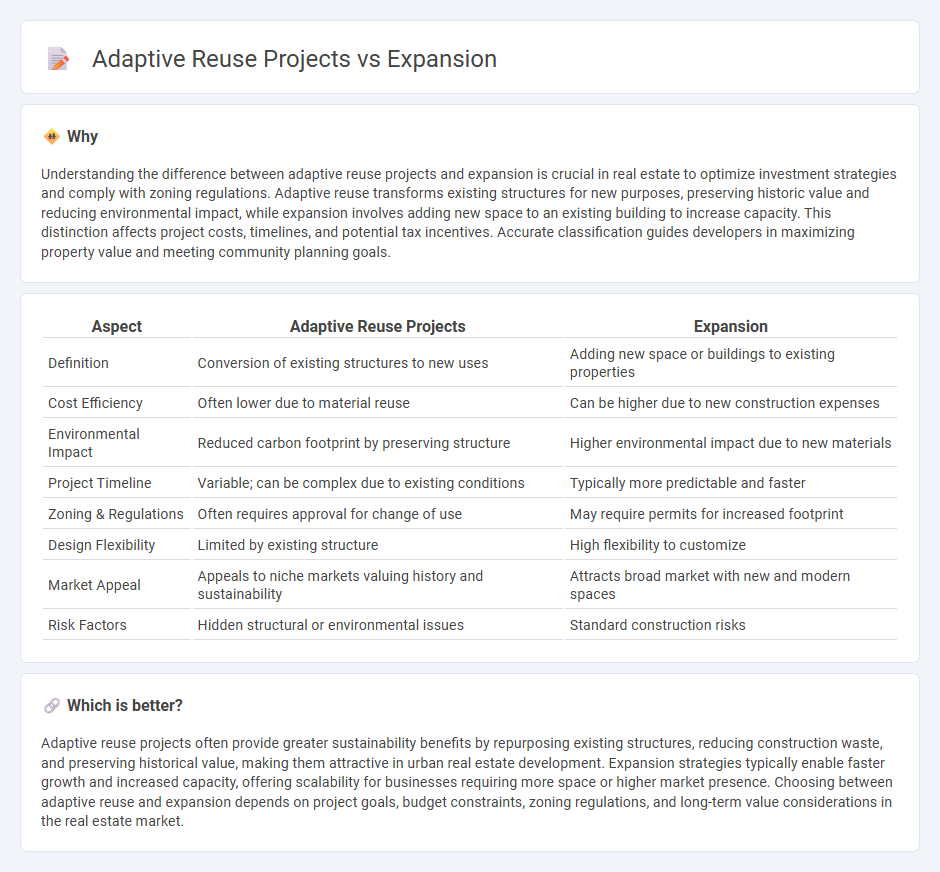
Adaptive reuse projects transform existing buildings by repurposing structures for new uses, preserving architectural heritage while optimizing resource efficiency. Expansion involves enlarging existing properties to increase space and capacity, often requiring new construction that complements the original design. Explore the benefits and challenges of both strategies to determine the best fit for your real estate investment goals.
Why it is important
Understanding the difference between adaptive reuse projects and expansion is crucial in real estate to optimize investment strategies and comply with zoning regulations. Adaptive reuse transforms existing structures for new purposes, preserving historic value and reducing environmental impact, while expansion involves adding new space to an existing building to increase capacity. This distinction affects project costs, timelines, and potential tax incentives. Accurate classification guides developers in maximizing property value and meeting community planning goals.
Comparison Table
| Aspect | Adaptive Reuse Projects | Expansion |
|---|---|---|
| Definition | Conversion of existing structures to new uses | Adding new space or buildings to existing properties |
| Cost Efficiency | Often lower due to material reuse | Can be higher due to new construction expenses |
| Environmental Impact | Reduced carbon footprint by preserving structure | Higher environmental impact due to new materials |
| Project Timeline | Variable; can be complex due to existing conditions | Typically more predictable and faster |
| Zoning & Regulations | Often requires approval for change of use | May require permits for increased footprint |
| Design Flexibility | Limited by existing structure | High flexibility to customize |
| Market Appeal | Appeals to niche markets valuing history and sustainability | Attracts broad market with new and modern spaces |
| Risk Factors | Hidden structural or environmental issues | Standard construction risks |
Which is better?
Adaptive reuse projects often provide greater sustainability benefits by repurposing existing structures, reducing construction waste, and preserving historical value, making them attractive in urban real estate development. Expansion strategies typically enable faster growth and increased capacity, offering scalability for businesses requiring more space or higher market presence. Choosing between adaptive reuse and expansion depends on project goals, budget constraints, zoning regulations, and long-term value considerations in the real estate market.
Connection
Adaptive reuse projects and expansion in real estate are interconnected through the strategic transformation and enlargement of existing structures to meet evolving market demands. Adaptive reuse maximizes asset value by converting obsolete buildings into functional spaces, while expansion leverages these upgraded assets to increase capacity or diversify uses. This synergy enhances urban development, sustainability, and investment potential by optimizing land use and reducing construction costs.
Key Terms
Zoning Regulations
Expansion projects often require compliance with zoning regulations related to building height, setback requirements, and floor area ratio, potentially triggering variances or special permits. Adaptive reuse projects must address zoning classifications that impact allowable uses, parking minimums, and historic preservation overlays, often necessitating zoning amendments or conditional use permits. Explore how specific municipal zoning codes influence these project types for informed planning and successful approvals.
Building Codes Compliance
Expansion projects require comprehensive compliance with current building codes, including structural integrity, fire safety, and accessibility standards to support increased occupancy and functionality. Adaptive reuse projects demand careful assessment of existing structures to integrate modern code requirements while preserving historical elements, often involving tailored solutions for seismic reinforcement and energy efficiency. Explore detailed strategies and regulatory considerations to effectively navigate building codes compliance in both expansion and adaptive reuse projects.
Site Feasibility Analysis
Site feasibility analysis for expansion projects involves evaluating land availability, zoning regulations, and infrastructure capacity to support new construction while meeting growth demands. Adaptive reuse feasibility prioritizes the structural integrity, historical preservation constraints, and compatibility with new functions within existing buildings. Explore detailed criteria and best practices for conducting comprehensive site feasibility analyses in both project types.
Source and External Links
EXPANSION | definition in the Cambridge English Dictionary - Expansion is an increase in the size, number, or importance of something, such as the rapid growth of an industry or trade.
Expansion (geometry) - Wikipedia - In geometry, expansion is a polytope operation involving moving facets radially apart and creating new facets, resulting in a uniform convex polytope.
EXPANSION definition in American English - Collins Dictionary - Expansion refers to the process or state of becoming larger or more extensive, and includes meanings in math and economics such as increased industrial activity.
 dowidth.com
dowidth.com